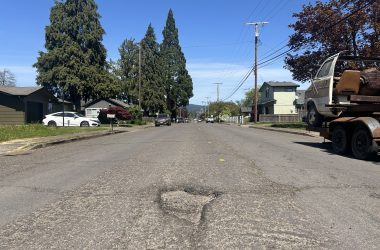Emergency: A sudden, unexpected serious situation that requires immediate action.
It’s because the need is sudden, and most often unexpected, that we need to be prepared at all times. We’ve been lucky here in the Willamette Valley; we haven’t had any major weather events beyond the frequent, and comparably mild, heat waves. We haven’t seen the wildfires that have hit other areas of Oregon and across the country. But we know we can expect a major earthquake in our lifetime. And don’t forget past windstorms, ice storms and record snowfalls, all of which have closed roads and knocked out power. These are the times we need to be prepared for. And the most important thing we need to have on hand is water.
How Much?
The recommendation is at least 3 gallons of water per person (or pet) per day. Plan on enough for at least 3 days – but a two-week supply is preferable. Children, nursing mothers and people who are ill may need more than the one gallon per day.
Water Storage Options
The simplest way to build your water supply is to purchase commercially bottled water. Multiple gallon jugs can take up a lot of room, but they are portable and easy to pour from. You can also buy water in 5-gallon containers. They take up less space than gallon bottles and the containers are more sturdy and reusable. Some may have spigots built in, if not spigots or other gadgets may be purchased for most containers to make them easier to use.
Alternatively, you can fill food-grade containers from your household water. Use soda bottles, juice bottles or other containers designed for the purpose. Do not reuse milk jugs, as they may harbor bacteria and the plastic they are made from will degrade with time. It is recommend that you sanitize recycled containers before using. Add bleach to clean water at a rate of 1 teaspoon per quart. Shake the container, making sure solution touches all parts of the bottle, for 30 seconds. Empty and allow to air dry. If your water comes from a well, even if it is known to be safe, should be purified before storage.

When filling containers, fill completely to the top to keep air out.
Water doesn’t go bad, but it may develop off flavors or simply taste flat after a year or so. Commercially bottled water is considered to have an indefinite shelf life.
Where to Store
It’s preferable to store water somewhere cool, out of direct sunlight. Indoors is best. Do not store directly on concrete, or near any volatile chemicals. It’s a good idea to stow water in more than one place, in case one becomes impossible to get to.
If outdoors, protect containers from temperature extremes the best you can.
Sanitizing Water
If you are forced to use water from outdoors, or your household water may be contaminated, here are some ways to make it safe.
Boiling: If you have a way to do so, boiling is the best way to make water safe to drink. Bring to a rolling boil for one minute then allow to cool.
If the water is cloudy, filter through a coffee filter or clean towel, or let it sit in a container until the impurities settle before boiling. Carefully empty the clear water into your pot, leaving any sediment behind.
Bleach: If you cannot boil the water, you may add a disinfectant such as chlorine bleach. Six drops per quart or 1/8 teaspoon per gallon. Let it sit for 30 minutes, then check that you can still detect a slight chlorine smell. If not, add another 1/8 teaspoon bleach and wait 15 minutes. If you still don’t notice a bleach smell, discard the water and find another source.
Filters: Filters and filtration devices may be used, but disinfectant is still recommended, as filters will not remove viruses or all bacteria.
Alternative Water Sources
If you run out of bottled water, there are other sources in your home you can tap. Also consider using these sources for washing up if you worry you won’t have enough bottled for drinking.
Hot water tank: Turn off gas/electric to tank. In an earthquake, or if you’ve been told your water supply has been compromised, turn off supply line as well. Use the valve at the bottom of the tank to access the water. The first water that comes out may have a lot of sediment, so wait until it comes out clear to fill your water bottles.
Household pipes: Even with the water supply off, there will be some water left in your pipes. Open the faucet nearest to the intake point to allow air into the pipes. Drain using the faucet farthest from the source.
Toilet tank: Unless cleaning disks are used in the tank, it should be clean. There may be sediment in the bottom, but the water is safe to drink. If that doesn’t appeal to you, use it for cleaning to conserve other sources.
Resources
■ tinyurl.com/AlmanacWater
■ ready.gov/water
■ tinyurl.com/AlmanacWater2








